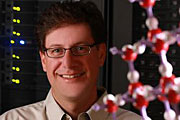- Number 341 |
- July 11, 2011
The choices that ions make

Dr. Chris Mundy.
From renewable energy to pharmaceuticals, iodide ions are a common but poorly understood actor, but scientists at DOE’s Pacific Northwest National Laboratory have found a way to learn more about iodide and better predict its behavior. The trick is to consider the less obvious choices of the electrons in the ion. Using this elegant and complex approach, Dr. Chris Mundy and Dr. Marcel Baer showed the ion congregates at the air-water interface at lower concentration than previously predicted. Better understanding of the electrons and the associated ion movement could change long-held assumptions and open new doors for basic energy research and climate studies.
The team’s new method considers the laws of quantum mechanics and Newton's laws of motion. The resulting calculations required leadership-class computers. The team used computers at DOE’s Oak Ridge National Laboratory, made available through the Department of Energy's INCITE award. Previous studies relied on are simpler mathematical models.
"Our work shows where some models may fail and where you may have to take into account the more subtle effects of electrons when performing calculations," said Mundy, the physical chemist who co-authored the study.
This research was funded by DOE's Office of Basic Energy Sciences, Chemical Sciences, Geosciences, and Biosciences Division.[Kristin Manke, 509.372.6011,
kristin.manke@pnnl.gov]
